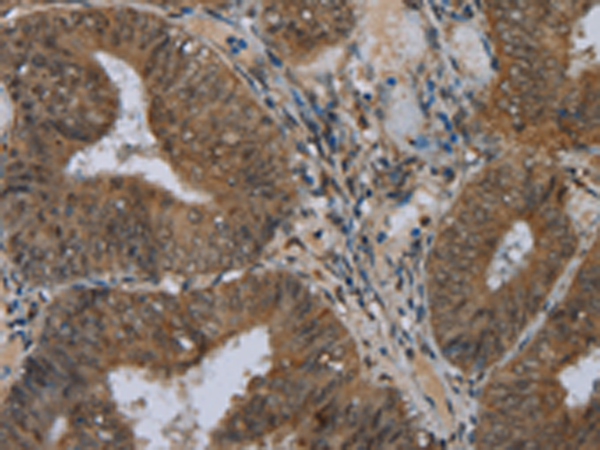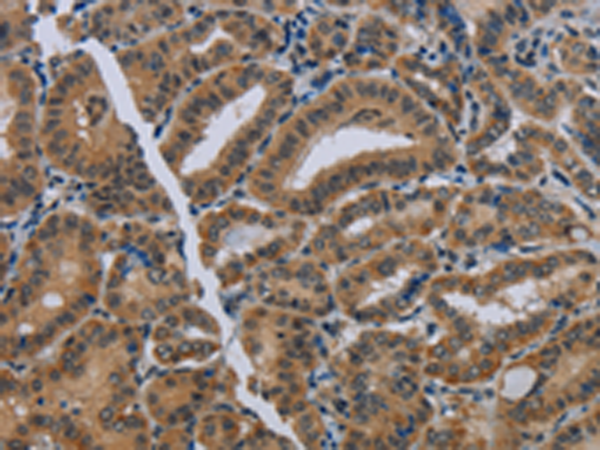


| WB | 咨询技术 | Human,Mouse,Rat |
| IF | 咨询技术 | Human,Mouse,Rat |
| IHC | 1/50-1/200 | Human,Mouse,Rat |
| ICC | 技术咨询 | Human,Mouse,Rat |
| FCM | 咨询技术 | Human,Mouse,Rat |
| Elisa | 1/2000-1/5000 | Human,Mouse,Rat |
| Aliases | ALP; NET43 |
| WB Predicted band size | 116 kDa |
| Host/Isotype | Rabbit IgG |
| Antibody Type | Primary antibody |
| Storage | Store at 4°C short term. Aliquot and store at -20°C long term. Avoid freeze/thaw cycles. |
| Species Reactivity | Human, Mouse |
| Immunogen | Fusion protein of human NAT10 |
| Formulation | Purified antibody in PBS with 0.05% sodium azide and 50% glycerol. |
+ +
以下是关于NAT10抗体的3篇参考文献示例(注:以下内容为模拟示例,实际文献需根据具体数据库检索验证):
1. **文献名称**:*NAT10-mediated ac4C modification enhances mRNA stability and translation in human cells*
**作者**:Arango D, et al.
**摘要**:该研究揭示了NAT10通过催化mRNA的ac4C修饰调控基因表达。研究中利用NAT10抗体进行免疫沉淀和Western blot,验证了NAT10在RNA修饰中的关键作用及其与癌症进展的关联。
2. **文献名称**:*NAT10 promotes colorectal cancer progression by acetylating PCNA mRNA*
**作者**:Liu H, et al.
**摘要**:本文发现NAT10通过乙酰化PCNA mRNA促进结直肠癌细胞增殖。研究使用NAT10抗体进行免疫组化(IHC)和免疫荧光(IF),证实其在肿瘤组织中高表达且与患者预后不良相关。
3. **文献名称**:*Depletion of NAT10 attenuates DNA damage response via impairing ac4C-dependent RNA metabolism*
**作者**:Wang Y, et al.
**摘要**:该研究通过NAT10抗体介导的基因沉默实验,证明NAT10缺失导致DNA损伤修复缺陷,其机制与ac4C修饰介导的RNA代谢失调有关,为靶向NAT10的抗癌策略提供依据。
**注意**:以上文献信息为示例性质,建议通过PubMed、Google Scholar等平台以“NAT10 antibody”、“NAT10 ac4C”等关键词检索真实文献。
NAT10 (N-acetyltransferase 10) is an evolutionarily conserved enzyme belonging to the GCN5-related N-acetyltransferase (GNAT) family. It catalyzes the transfer of acetyl groups to RNA, particularly mediating N4-acetylcytidine (ac4C) modification, a conserved epitranscriptomic mark found in eukaryotic mRNAs and tRNAs. This acetylation plays a role in regulating RNA stability, translation efficiency, and cellular stress responses. NAT10's involvement in diverse biological processes, including cell proliferation, DNA damage repair, and nucleolar function, has made it a subject of interest in cancer, aging, and developmental studies.
NAT10-specific antibodies are critical tools for investigating its expression, localization, and molecular interactions. They are widely used in techniques like Western blotting, immunofluorescence, and immunoprecipitation to study NAT10's role in health and disease. Research has linked NAT10 dysregulation to tumor progression, metastasis, and chemoresistance in cancers, as well as age-associated pathologies. Antibodies targeting NAT10 have also facilitated the exploration of its crosstalk with other epigenetic regulators and its potential as a therapeutic target. Commercial NAT10 antibodies are typically developed against conserved regions (e.g., amino acid residues 600-850 in humans) and validated for species reactivity (human, mouse, rat) and application-specific performance. Recent studies emphasize the importance of NAT10 in RNA metabolism, positioning these antibodies as essential reagents for epitranscriptomics research.
×